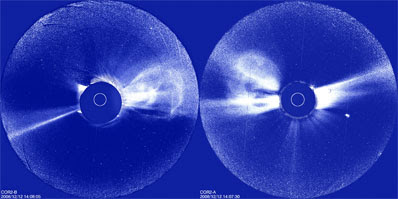Astronomy

- Cosmic Rays Accelerated By Exploded Stars
Using ESO?s Very Large Telescope and NASA?s Chandra X-ray Observatory, astronomers have shown that cosmic rays from the Milky Way are very efficiently accelerated in the remnants of exploded stars. Cosmic rays are extremely energetic particles ? mostly...
- The Mystery Of The Missing Sunspots Explained
An unusually slow-moving solar jet stream buried deep inside the Sun is causing the lack of sunspots and low solar activity, say scientists from the National Solar Observatory (NSO). The Sun usually follows a fairly regular pattern, cycling through...
- Twin Spacecraft May Reveal Secret Of Moon's Origin
Two places on opposite sides of Earth may hold the secret to how the moon was born. NASA's twin Solar Terrestrial Relations Observatory (STEREO) spacecraft are about to enter these zones, known as the L4 and L5 Lagrangian points, each centered about...
- Nasa's Spacecraft Has Captured A Solar Shockwave In Action For The First Time Ever
On Oct. 8, 2013, an explosion on the Sun's surface sent a supersonic blast wave of solar wind out into space. This shockwave tore past Mercury and Venus, blitzing by the Moon before streaming toward Earth. The shockwave struck a massive blow to the...
- Voyager 1 Is Going Under Tsunami Wave.
NASA's Voyager 1 spacecraft is continuously experiencing a "Tsunami wave" as it enter the interstellar medium beyond the solar system.The spacecraft launched in 1977 is the farthest [travelling 19.5 billion km(approx) away from earth]...
Astronomy
NASA spacecraft show 3-D anatomy of a solar storm

WASHINGTON -- Twin NASA spacecraft have provided scientists with their first view of the speed, trajectory, and three-dimensional shape of powerful explosions from the sun known as coronal mass ejections, or CMEs. This new capability will dramatically enhance scientists' ability to predict if and how these solar tsunamis could affect Earth.
When directed toward our planet, these ejections can be breathtakingly beautiful and yet potentially cause damaging effects worldwide. The brightly colored phenomena known as auroras -- more commonly called Northern or Southern Lights -- are examples of Earth's upper atmosphere harmlessly being disturbed by a CME. However, ejections can produce a form of solar cosmic rays that can be hazardous to spacecraft, astronauts and technology on Earth.
- Cosmic Rays Accelerated By Exploded Stars
Using ESO?s Very Large Telescope and NASA?s Chandra X-ray Observatory, astronomers have shown that cosmic rays from the Milky Way are very efficiently accelerated in the remnants of exploded stars. Cosmic rays are extremely energetic particles ? mostly...
- The Mystery Of The Missing Sunspots Explained
An unusually slow-moving solar jet stream buried deep inside the Sun is causing the lack of sunspots and low solar activity, say scientists from the National Solar Observatory (NSO). The Sun usually follows a fairly regular pattern, cycling through...
- Twin Spacecraft May Reveal Secret Of Moon's Origin
Two places on opposite sides of Earth may hold the secret to how the moon was born. NASA's twin Solar Terrestrial Relations Observatory (STEREO) spacecraft are about to enter these zones, known as the L4 and L5 Lagrangian points, each centered about...
- Nasa's Spacecraft Has Captured A Solar Shockwave In Action For The First Time Ever
On Oct. 8, 2013, an explosion on the Sun's surface sent a supersonic blast wave of solar wind out into space. This shockwave tore past Mercury and Venus, blitzing by the Moon before streaming toward Earth. The shockwave struck a massive blow to the...
- Voyager 1 Is Going Under Tsunami Wave.
NASA's Voyager 1 spacecraft is continuously experiencing a "Tsunami wave" as it enter the interstellar medium beyond the solar system.The spacecraft launched in 1977 is the farthest [travelling 19.5 billion km(approx) away from earth]...
